The Northern Mountains Class 4 Notes SST
| Table of contents |

|
| The Northern Mountains |

|
| Life in the Region |

|
| Mountaineering & it's Hazards? |

|
| Importance of Himalayas |

|
| Keep in Mind! |

|
The Himalayas stand tall in the north and north-eastern parts of India, holding the title of the world's highest mountain range. They derive their name from "Him" meaning ice and "alaya" meaning place of, signifying their snowy peaks.
The Northern Mountains
The Himalayan Mountains form the northern mountain region of India. They are the highest mountain ranges in the world. Some prominent features are highest peaks, deep valleys & gorges, glaciers etc.
 Three Parallel Ranges of the Northern Mountains
Three Parallel Ranges of the Northern Mountains
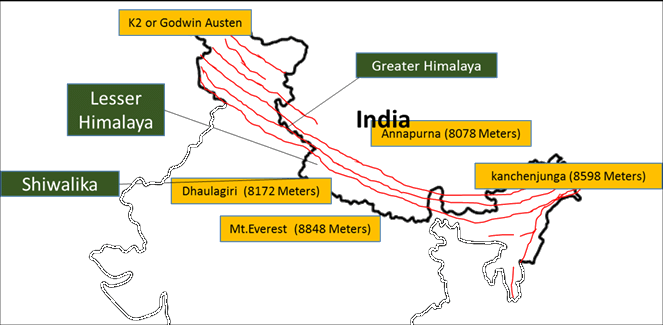 The Three Mountain Ranges
The Three Mountain Ranges
(i) Himadri or Greater Himalaya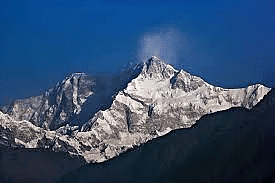 Greater Himalayas
Greater Himalayas
- The Great Himalayas are the highest and northernmost range among the three parallel ranges. The Greater Himalaya is way up in the north.
- They consist of some of the highest peaks in the world, including Mount Everest and K2.
- They are the tallest of the three mountain ranges. The climate of the area is snowy all year round and the region consists of glaciers.
- Many big rivers like the Indus, Ganga, Yamuna, and Brahmaputra start from these glaciers.
(ii) The Lesser Himalayas (Himachal or Lower Himalayas)
- Situated to the north of the Shiwalik Range, the Lesser Himalayas are higher in altitude.
- They include prominent mountain ranges such as the Dhauladhar Range and the Pir Panjal Range. These mountains have lots of trees like pine, fir, and deodar.
 Deodar, Pine, Fir Trees
Deodar, Pine, Fir Trees - You'll find famous places like Shimla, Nainital, and Darjeeling here. They're called hill stations because they're high up in the mountains and people like to go there for vacations.
(iii) The Shiwalik Range or Outer Himalayas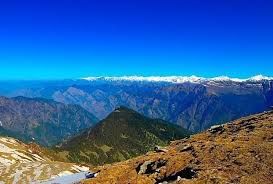 Shiwalik Hills
Shiwalik Hills
- The Outer Himalaya is even lower than the Middle Himalaya. It's covered with wild forests. There are many wild animals living in these forests.
- The Shiwalik is the southernmost range of the Himalayas. The other ranges have been formed much earlier.
- The average height of the Shiwalik ranges is about 600 meters only. There are some broad valleys in between the Himachal and the Siwalik ranges which are known by the name “duns”. Dehradun is one of them.
- The Siwalik ranges are home for a wide variety of wildlife. Very limited farming is done by people living in these areas. The farming is done on steps which is known as terrace farming.
Life in the Region
Ladakh
- Situated in the Himalayas and the Karakoram Range, Ladakh is known for its farming practices.
 Karakoram Ranges
Karakoram Ranges - Due to the scarcity of flat land, farmers practice terrace farming on the slopes, cultivating crops such as rice, maize, barley, and potatoes. Some engage in sheep rearing and wood carving.
 Sheep Rearing(left) & Wood Carving(right)
Sheep Rearing(left) & Wood Carving(right) - The region is famous for its apple orchards and saffron cultivation. Traditional attire includes long woolen kurtas called phirans and salwars.
- During winters, people use kangris to keep warm and drink kahwa, a special tea. Tourist attractions include Srinagar, Gulmarg, and Amarnath.
Himachal Pradesh
- Famous for its apple orchards, Himachal Pradesh sees men wearing embroidered caps called Kullu caps, while women wear scarves called dhazu.
- The region hosts the popular Kullu Dussehra festival and attracts tourists to places like Shimla, Dalhousie, and Manali.
Uttarakhand
 Lychees and Plums
Lychees and Plums
- Known for basmati rice, lychees, and plums, Uttarakhand is also recognized for weaving woolen shawls, scarves, and rugs.
- Tourists flock to Mussoorie, Nainital, and Haridwar for their scenic beauty and cultural significance.
Sikkim
 Bakhu: Sikkim's Traditional Dress
Bakhu: Sikkim's Traditional Dress
- Famous for oranges, cardamom, and orchids, Sikkim sees men and women wearing a loose gown called bakhu, along with colorful jewelry made from beads.
- Gangtok and Pelling are popular tourist destinations.
Purvachal Hill Ranges
 Purvanchal Ranges
Purvanchal Ranges
Arunachal Pradesh
- Famous for fruit orchards and orchids, Arunachal Pradesh is also known for wood carving, carpet weaving, and bamboo and cane products.
 Itanagar And Tawang Ranges
Itanagar And Tawang Ranges - Itanagar, Ziro, and Tawang are popular tourist spots.
Nagaland
- Apart from farming and weaving, wood carving and pottery are significant occupations in Nagaland.

- The Nagas wear shawls with distinctive designs, representing their tribal identity. Kohima and Dimapur are notable tourist destinations.
Manipur
- Fruits like lychee, chestnut, walnut, papaya, and passion fruit are grown in Manipur, where craftsmen produce bamboo, cane, and leather articles.
 Manipuri dance
Manipuri dance - The Manipuri dance is renowned, and places like Imphal and Ukhrul attract tourists.
Mizoram
- Traditional farming in Mizoram has been replaced with fruit and rose cultivation, with some people involved in silk production.
- Chapchar Kut, celebrated in March, is an important festival.
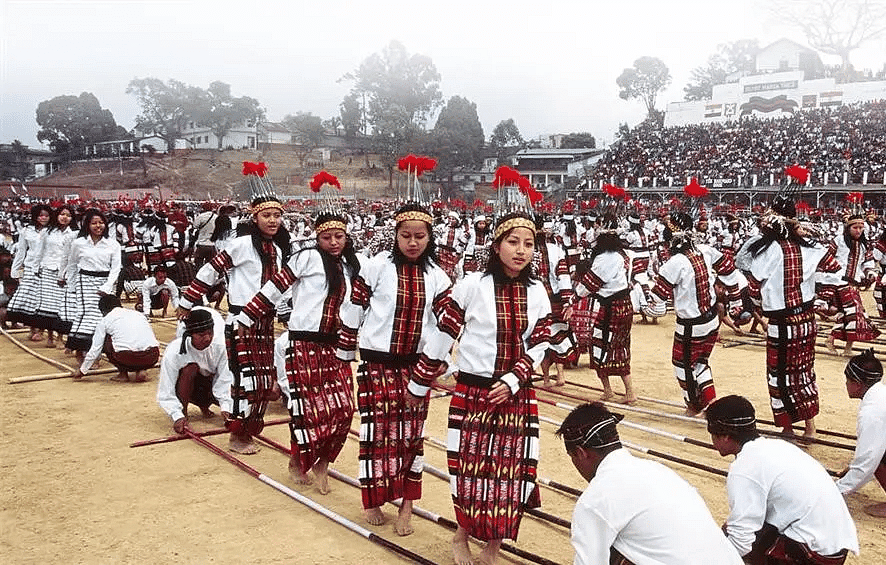 Chapchar Kut
Chapchar Kut
Tripura
- Jute, rubber, and bamboo are grown in Tripura, with bamboo being used for handicrafts.
- The state is known for its Bangla and Kokborok-speaking populace, and places like Agartala and Unakoti are tourist hotspots.
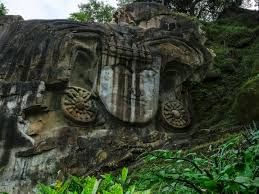 Unakoti
Unakoti
Meghalaya
- Home to the Garo, Khasi, and Jaintia tribes, Meghalaya is known for the Strawberry Festival.
- The languages widely spoken are Khasi and Garo, and tourists are drawn to places like Shillong and Cherrapunji for their natural beauty.
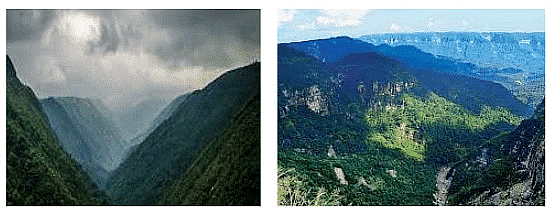
Important Key Points
- The high mountain peaks lie in the Himadri ranges.
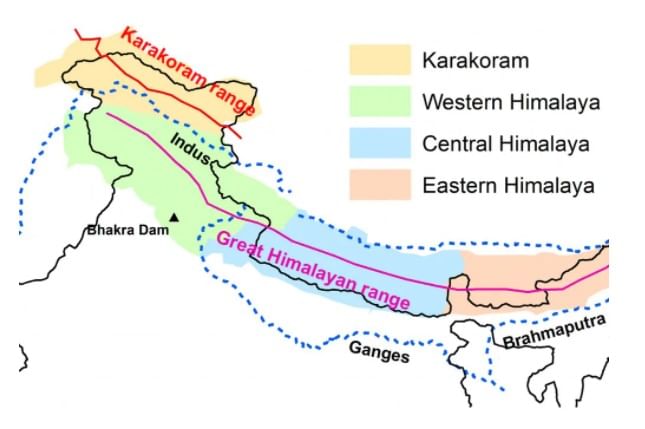 The Northern Mountains
The Northern Mountains
- Mount Everest in Nepal is the world's highest mountain peak.
- The highest mountain peak within Indian territory is Kanchenjunga. The other important mountain peaks in India are Dhaulagiri and Nanda Devi.
- The world's second-highest peak K2 is situated in Jammu and Kashmir. It is part of the Karakoram Range.Question for Chapter Notes: The Northern MountainsTry yourself:Which among the following is the highest range of the Himalayas?View Solution
- The high peaks remain covered with snow all over the year. There is no vegetation or animal habitation over there. But high peaks have always challenged mountaineers.
Mountaineering & it's Hazards?
- On May 29, 1953, two mountaineers, Tenzing Norgay of India and Edmund Hillary of New Zealand, climbed the highest mountain top–Everest.
 Edmund Hillary, Tenzing Norway and Junko Tabei
Edmund Hillary, Tenzing Norway and Junko Tabei - In 1984, Bachendri Pal became the first Indian woman to climb Mount Everest.
 Bachendri Pal
Bachendri Pal
Hazards of Mountaineering
- Mountaineers need protection from severe cold and frost. But there is limit to how much baggage can be taken up.
- So the clothing has to be quilted and light. The air up on the mountains is rare. Breathing becomes difficult due to lack of oxygen.
- Mountaineers carry oxygen cylinders with them for use beyond a certain height.
- The glare of the sun's reflection from ice can seriously damage the eyes. As such, mountaineers have to wear special glasses.

Special clothing of Mountaineers
Helpful High Peaks
- Besides posing a challenge to mountaineers, the high peaks are useful in many more ways. Huge blocks of ice from these mountain tops flow down as rivers of ice. They are known as Glaciers.
- As these glaciers move into warmer regions, the snow melts. Rivers like the Ganga and the Yamuna originate from the glaciers Gangotri and Yamunotri. During the summer months, these rivers do not get dry.
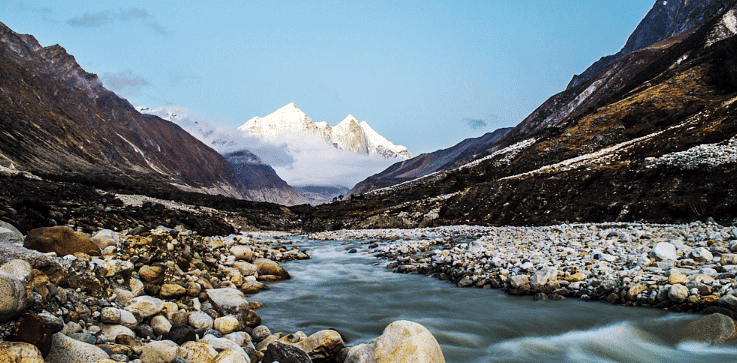 Gangotri Glacier
Gangotri Glacier - The melting snow feeds them with water. Melting snow also keeps other rivers like the Satluj and the Brahmaputra full of water during the summer months.
Importance of Himalayas
- The Himalayas have been a boon to us in many ways. They protect us from the very cold winds that blow in the north.
- But for the Himalayas, northern parts of India would have been a barren cold dry desert. The rivers originating from the Glaciers bring along with them soft rocks. As the bits roll down, they are transformed into fertile soil.
- Every year, as the rivers flood, the fertile soil is laid upon the river banks.
- The Himalayas were at one time our sentries in the north. But that is no longer true. There are gaps called Passes within the high mountain ranges.
Important Fact:
In 327 B.C. Alexander came all the way from Greece and entered India through the Khyber Pass. This pass joins Afghanistan to what is now Pakistan. In 1962, the Chinese forces attacked India using the Nathula (means pass) joining Sikkim to Tibet.
Keep in Mind!
- The Himalayas are the world's mightiest mountain ranges.
- The Himalayas stretch between J and K, Himachal Pradesh, West Bengal, Sikkim, Bhutan and Arunachal Pradesh. Along the way, Himalayas run through Nepal.
- Mount Everest is the world's highest mountain peak (8,848 m)
- Kanchenjunga (8,585 m) in Sikkim (India) is the second highest peak.
- Tenzing Norgay was the first Indian to have climbed Everest. Bachendri Pal was the first Indian woman to have climbed Everest. Santosh Yadav climbed Everest twice which is a world record.
- Himadri, Himachal and Siwalik are three mountain ranges of the Himalayas.
- The Himalayas protect us from cold winds blowing in the north. The Glaciers keep the rivers flowing during summers. The beautiful valleys, fertile plains, varieties of wildlife and rich forest produce are all gifts from the Himalayas.
- There is need for saving the Himalayan forests and wildlife.
|
50 videos|246 docs|46 tests
|
FAQs on The Northern Mountains Class 4 Notes SST
| 1. What are the main features of the Northern Mountains? |  |
| 2. How does life in the Northern Mountains differ from life in other regions? |  |
| 3. What are the common hazards faced in mountaineering? |  |
| 4. Why are the Himalayas important to the environment and culture? |  |
| 5. What precautions should be taken when trekking in the Northern Mountains? |  |
















